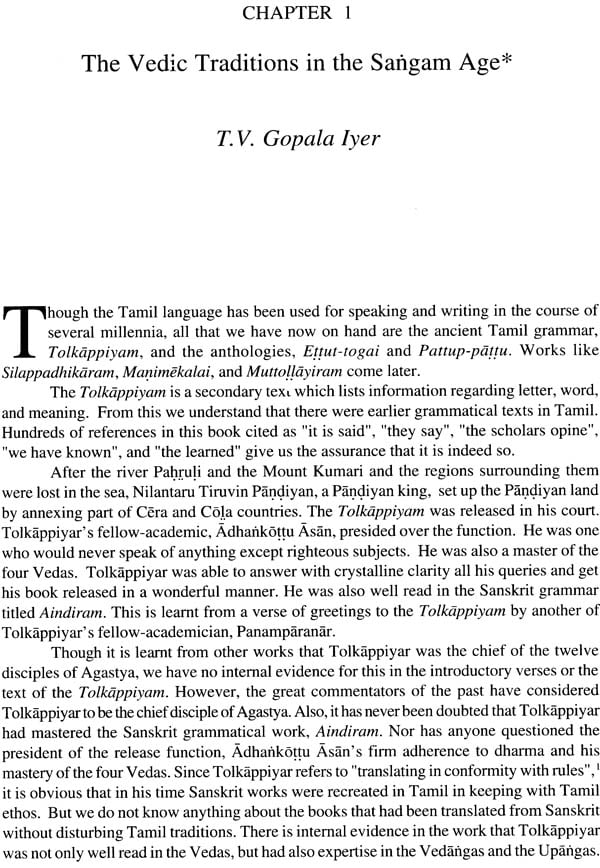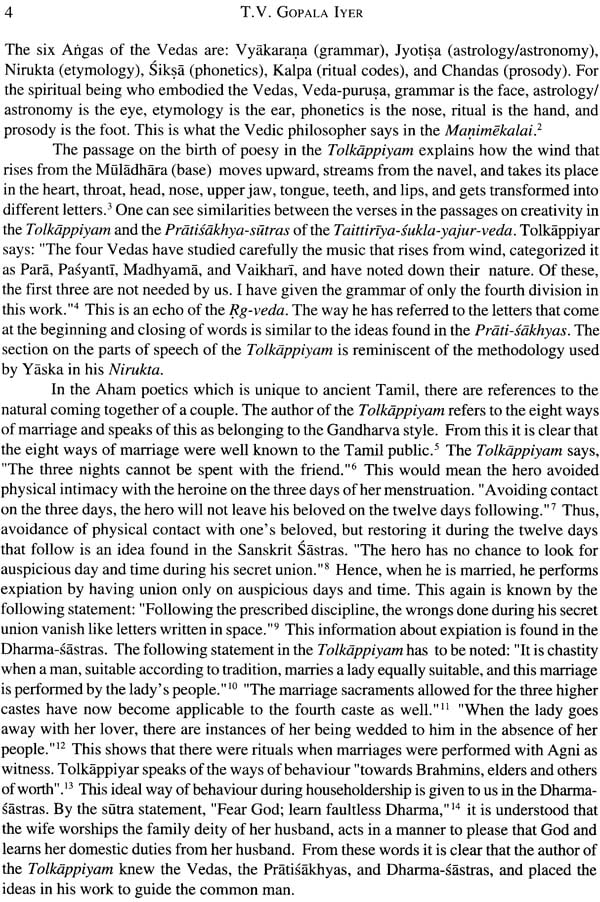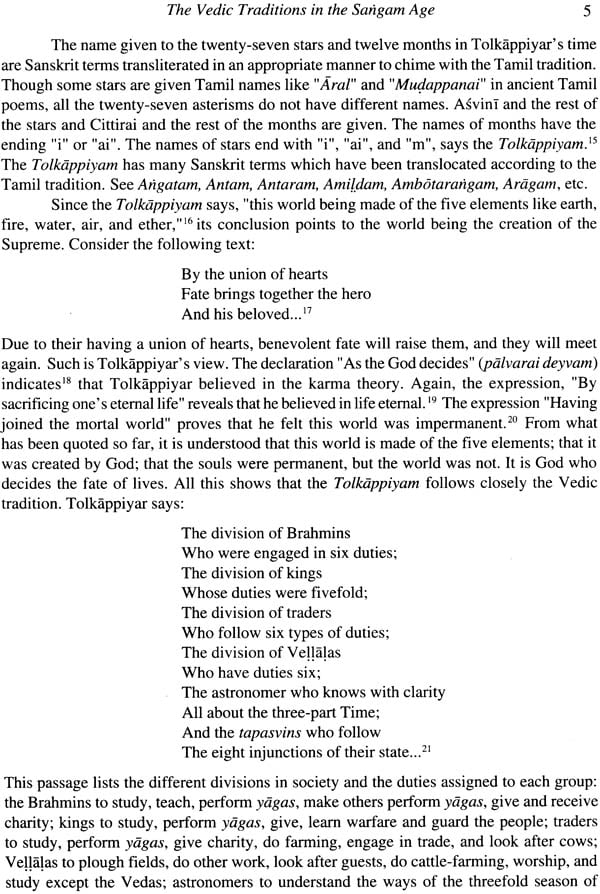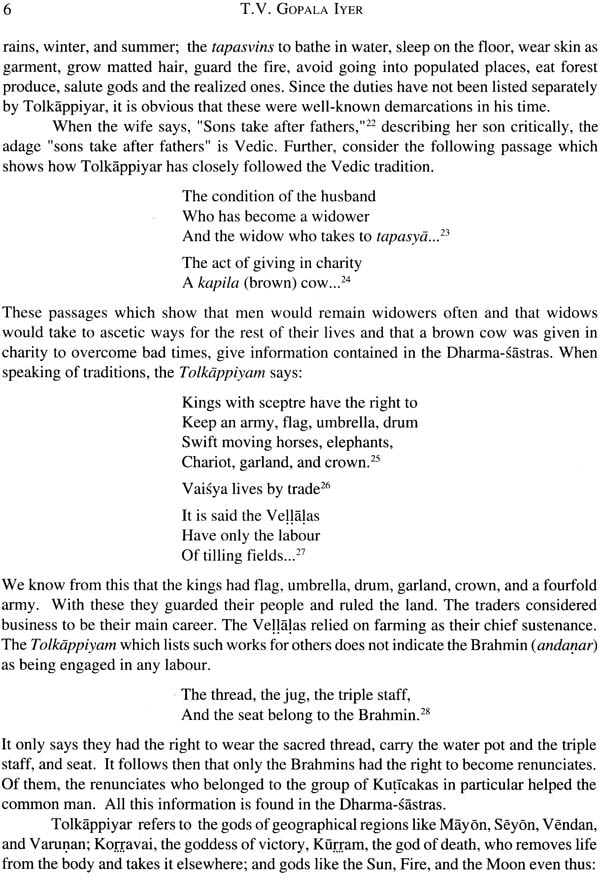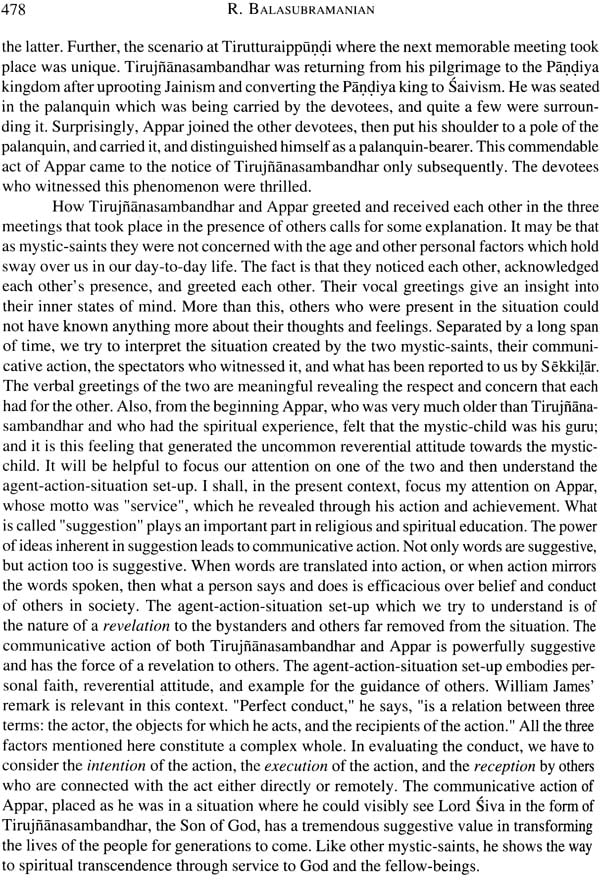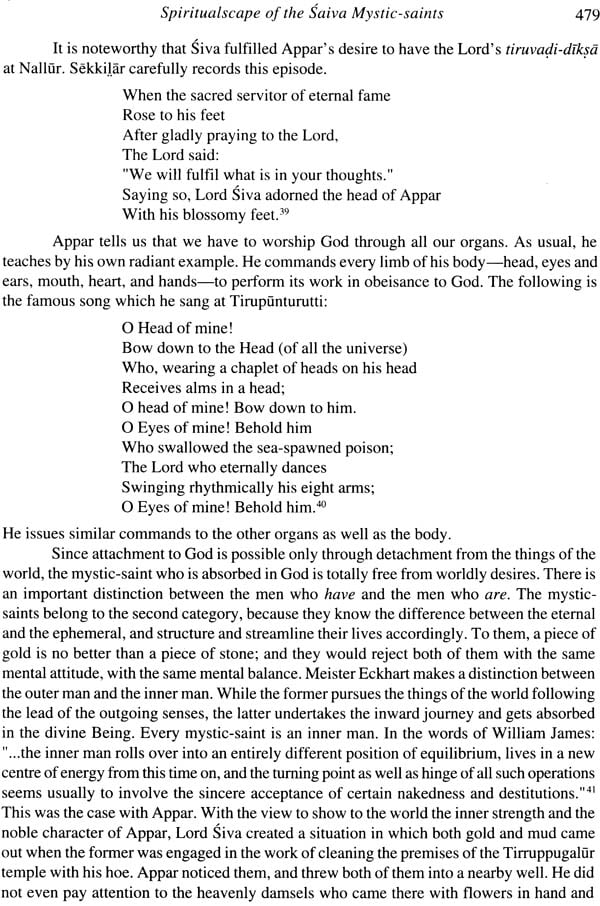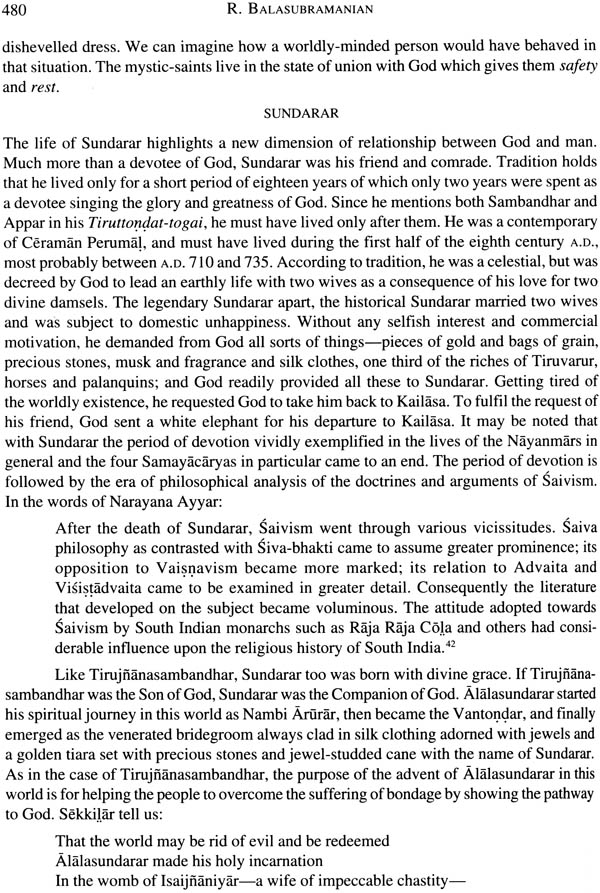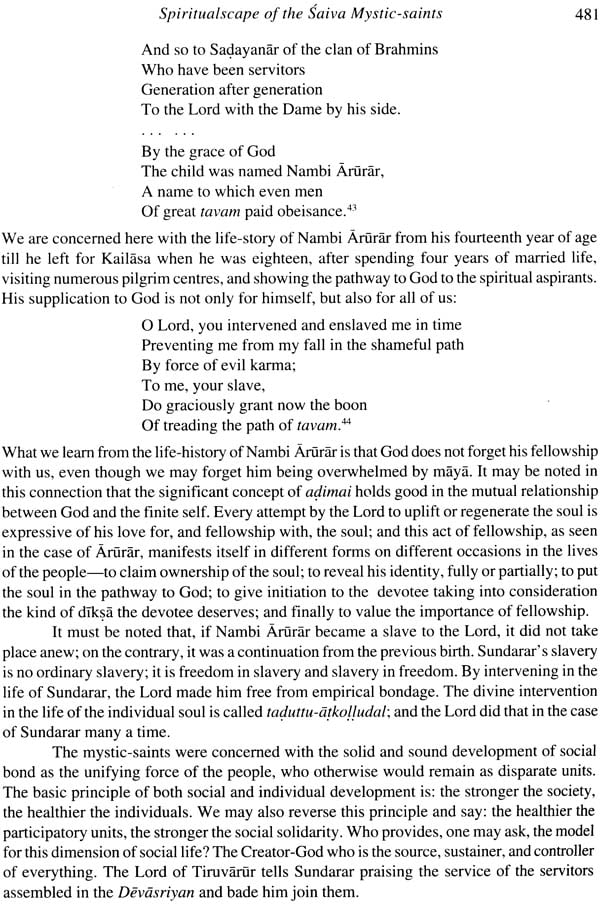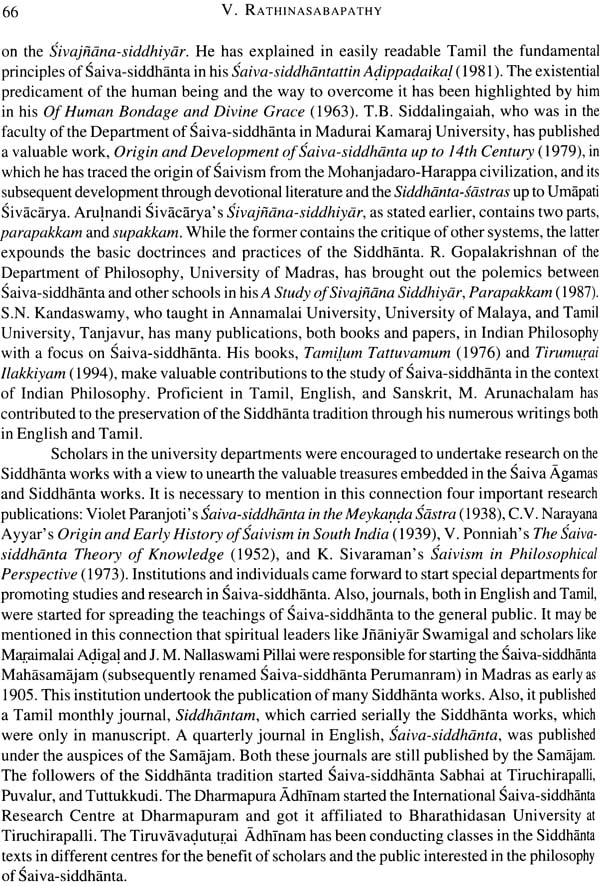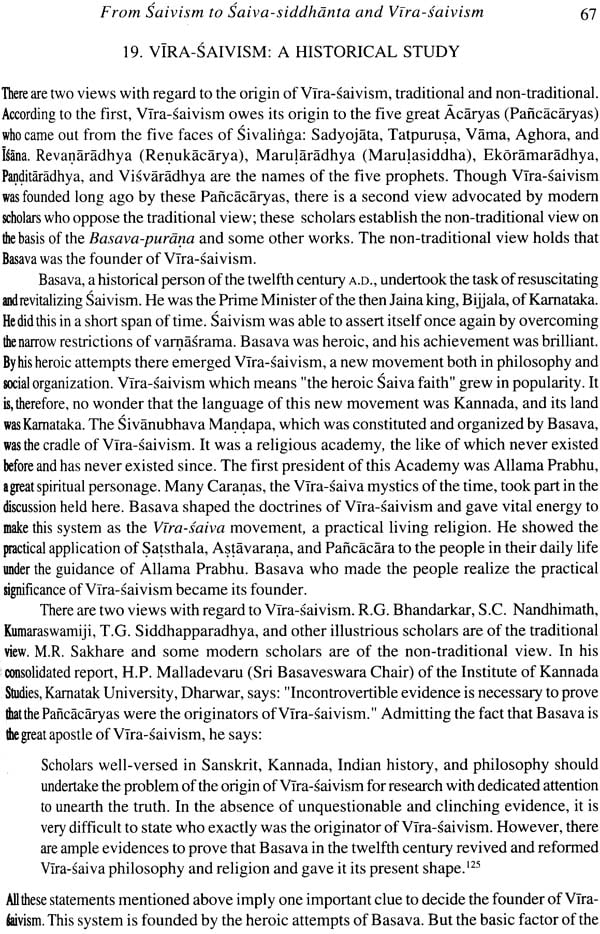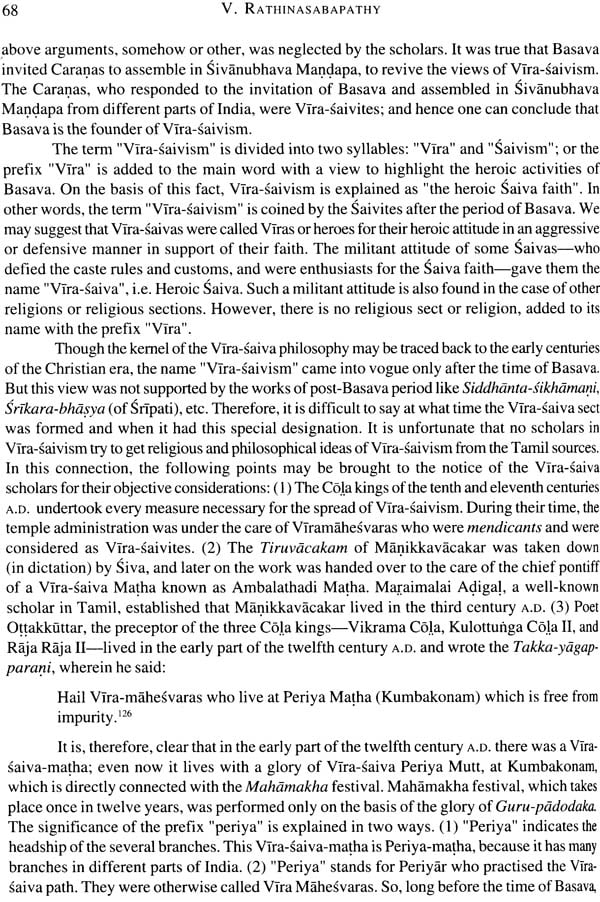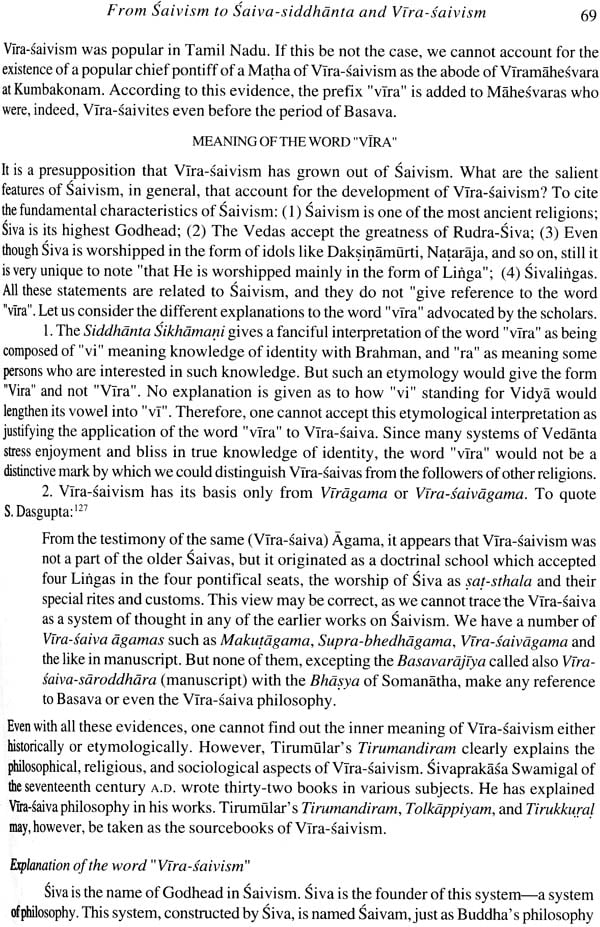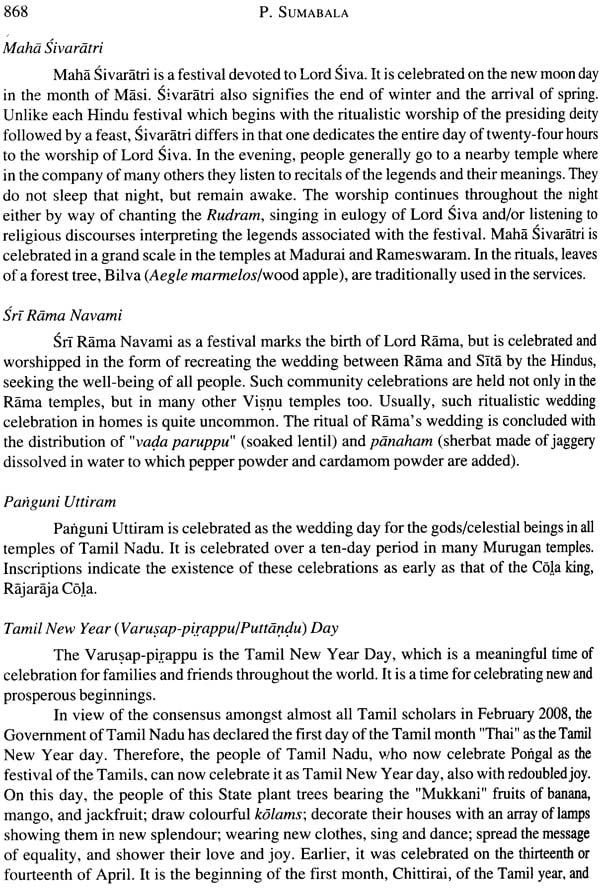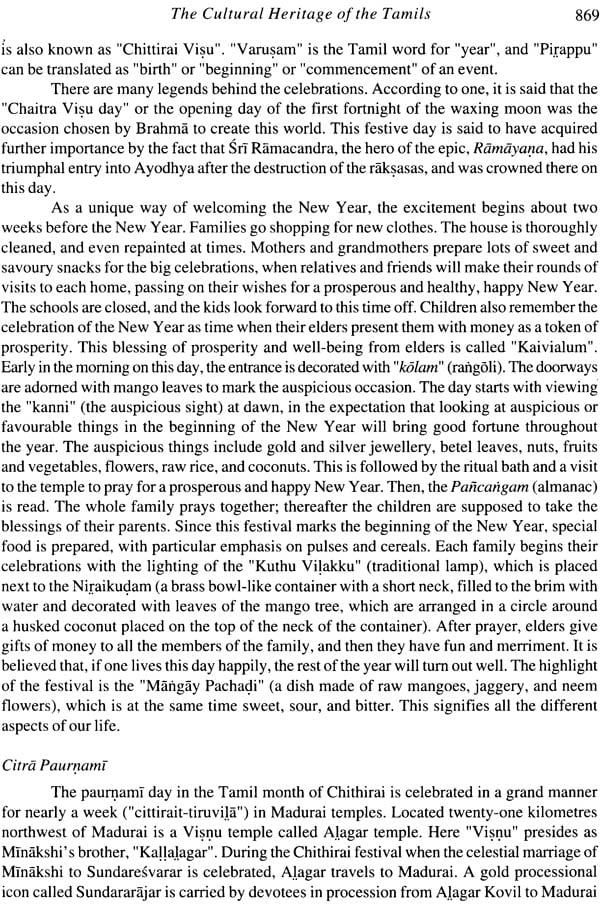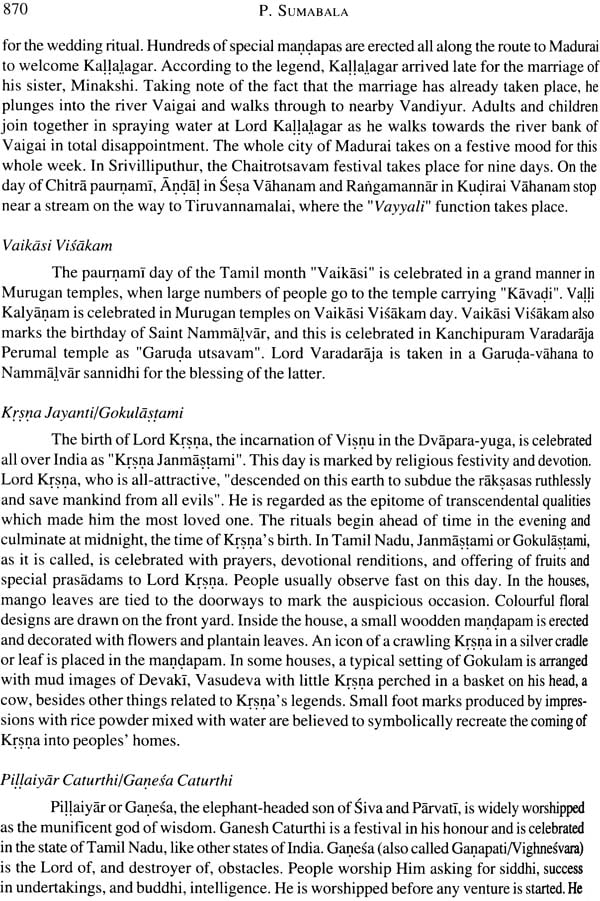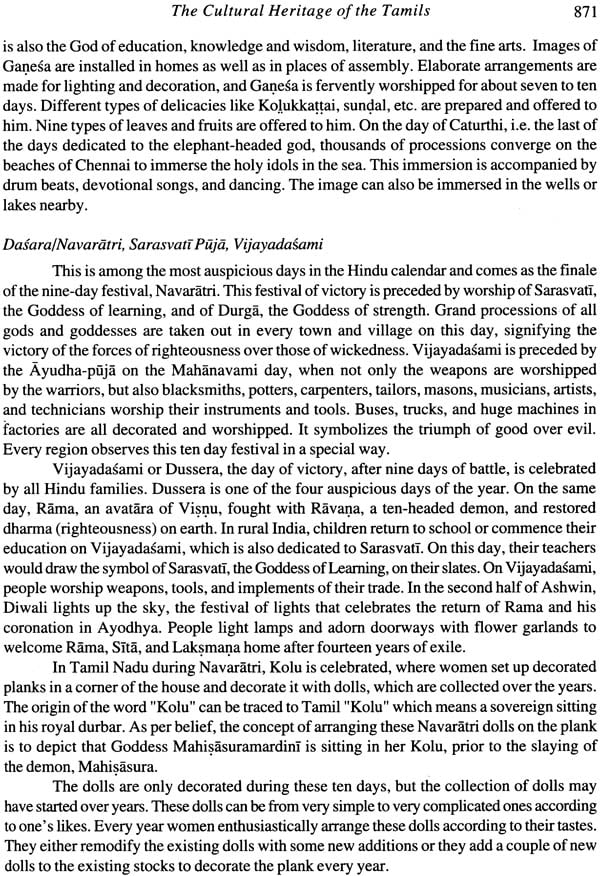
The Life World of the Tamils: Past and Present in Two Volumes (Set of 2 Volumes)
Book Specification
| Item Code: | NAF472 |
| Author: | D.P.Chattopadhyaya and R. Balasubramanian |
| Publisher: | Centre for Studies in Civilizations |
| Edition: | 2009 |
| ISBN: | 9788187586333 |
| Pages: | 1757 |
| Cover: | Hardcover |
| Other Details | 11.5 inch x 8.5 inch |
| Weight | 5 kg |
Book Description
Past and Present - I
The volumes of the Project on The History of Science, Philosophy and culture in Indian civilization aim at discovering the main aspects of India’s heritage and present them in an interrelated way. These volumes, in spite of their unitary look, recognize the difference between the areas of material civilization and those of ideational culture. The project is not being executed by single group of thinkers and writers who are methodologically uniform or ideologically identical in their commitments. In fact, contributions are made by different scholars with different ideological persuasions and methodological approaches. The Project is marked by what may be called ‘methodological pluralism’.
In spite of its primary historical character, this Project, both in its conceptualization and execution, has been shaped by many scholars drawn from different disciplines. It is for the first time that an endeavour of such a unique and comprehensive character has been undertaken to study critically a major world civilization like India.
This volume tries to bring out the material civilization and the spiritual culture of the life-world of the Tamils from 5th century B.C. up to 12th century A. D. It covers the Sangam and post-Sanam thinkers and works as well as the entire devotional and mystical literature highlighting the salient features of the everyday life of the people, their philosophy and religion, the social, economic and political organization that was prevalent in those days. As the spokesman of the Tamil culture, Tiruvalluvar brought out the importance of the pursuit of wealth (artha), the cultivation of virtues (aram), and the enjoyment of life (inbam) for achieving spiritual transcendence. This is the message conveyed by the Tamil tradition to the present generation.
This volume will be of interest not only to students and scholars of philosophy, but also to social philosophers and cultural historians.
Past and Present - II
The volumes of the PROJECT ON THE HISTORY OF SCIENCE, PHILOSOPHY AND CULTURE IN INDIAN CIVILIZATION aim at discovering the main aspects ofIndia's heritage and present them in an interrelated way. These volumes, in spite of their unitary look, recognize the difference between the areas of material civilization and those of ideational culture. The Project is not being executed by a single group of thinkers and writers who are methodologically uniform or ideologically identical in their com- mitments. In fact, contributions are made by different scholars with different ideological per-suasions and methodological approaches. The Project is marked by what may be called 'methodological pluralism' .
In spite of its primary historical character, this Project, both in its conceptualization and execution, has been shaped by many scholars drawn from different disciplines. It is for the first time that an endeavour of such a unique and comprehensive character has been undertaken to study critically a major world civilization like India.
This Volume, which is Part II of the Life-world of the Tamils: Past and Present, tries to bring out the material civilization and the spiritual culture of the life-world of the Tamils from 13th century down to the present time. It covers the commentarial tradition on Saivism and Vaisnavism, the Riimdyana and the Mahiibharata; the development of the Tamil literature from 13th century; the Islamic and Christian contributions to Tamil; social and cultural critique of every-day-life contained in Tamil novels, short stories, and journals; political parties and reform movements towards political, social, economic justice; and the spiritual and cultural heritage of the Tamils.
Thus, the life-world of the Tamils, past and present, has been discussed in detail in two Volumes running to nearly 2,000 pages. This Part, like the previous one, will be of interest not only to students and scholars of philosophy, but also to social philosophers and cultural historians.
D. P. Chattopadhyaya, M. A. , L. L.B., Ph.D. (Calcutta and London school of Economics), D. Litt. (Honoris Causa), researched, studied Law, Philosophy and History and taught at various Universities in India, Asia, Europe and USA from 1954 to 1994. Founder-Chairman of the Indian Council of Philosophical Research (1981-1990) and President-cum-chairman of the Indian Institute of Advanced Study, Shimla (1984-1991), Chattopadyaya is currently the Project Director of the multidisciplinary 96- volume PHISPC, Chairman of the CSC and chairman of the Indian Philosophical congress. He is a Life Member of the Russian Academy of Sciences and a Among his 35 books, authored 18 and edited 17, are Individuals and societies; Individuals and worlds; Sri Aurobindo and karl Marx; Anthropology and Historiography of science; Induction, Probability and skepticism; sociology, Ideology and Utopia; Societies, Cultures and Ideologies; Interdisciplinary studies in science, society, Value an Civilization Dialogue and Philosophy of science, Phenomenology and other essays. Besides, he has held high public offices, namely, cabinet minister and state governor.
R. Balasubramanaian, Ph.D. and D. Litt. (Madras University), Vascaspati (Honoris Causa), a specialist in Advaita, Phenomenology and Existentialism, started his carrier in 1950. He taught in Besant The Theosophical college, Vivekanakda college and Annamalai university before joining the faculty of Radhakrishnan Institute for Advanced Study in Philosophy, university of Madras, of which he was the Director for a number of years. He started Sri Aurobindo school of Eastern and western Thought at Pondicherry University and was its first chairman for five years. He spent a year at Stanford University as a Full bright & smith-Mundt scholar for his post-doctoral studies. He was chairmanof Indian council of Philosophical Research for a term. He is at present visiting Professor, Sir Aurobindo school of Eastern and western Thought and president, Afro-Asian Philosophy Association. His publications include Personality Existentialism of Berdyaev; The Taitttiryopanisad-bhasya-vartika of suresvara; The Naiskarmya-siddhi; T. M. P.Mahadevan; Advaita Vedanta; Theistic Vedanta; The Enworlded Subjectivity : Its Three worlds and Beyond.
The volumes of the Project on the History of Indian Science, Philosophy, and Culture in Indian Civilization aim at discovering the main aspects of India’s heritage and present them in an interrelated way. They have always kept in mind the difference between the areas of material civilization and those of ideational culture. Keeping in view the objectives of the Project, Professor D. P. Chattopadhyaya, the Director of the Project, planned to bring out, among other. Some volumes which would highlight the salient features of language, literature, and arts in the context of Indian civilization. At his suggestion, I organized two regional seminars for the purpose of bringing our a volume on the: Contributions of the Tamils to Philosophy, Religion, Culture and Science “. These seminars helped me to identify the areas to be covered and the topics to be covered and the topics to be discussed in the present volume.
When I was planning the structure and the areas of this volume, it occurred to me that the expression “the life-world” (Lebenswelt) used by Husserl and his followers would bring out the full significance of the entire dimension of philosophy, religion, culture, and civilization. Hence, I decided to name this volume “The Life- world of the Tamils: Past and Present”. This title signifies the material civilization as well as the spiritual culture of the Tamils, past and present. Since the period to be focused is vast beginning from 5th century B.C. down to the present day, I decided to spilt the volume into two parts, Part I up to 12th century A. D. and Part II, the remaining period. Even after restricting the period for the first art, I have to be selective in the choice of thinkers and texts, a process which resulted in the omission of some texts/thinkers. For example, there is the significant omission of Tirumualr. Nor could we discuss all the aspects of even one text, e.g. Tolkappiyam or Tiurkkural. This has become inevitable in view of the fact that the focus of this volume is on philosophy, religion, culture, and science; and so the scope, perspective, and discussion of the topics in this volume are different from those discussed in books dealing with the history of Tamil literature, social and political history of the Tamils, and so on. The two books of the Sangam period, Tolkappiyam an Tirukkural, herald the salient features of the day-today life of the people, their philosophy and religion, the social, economic, and political organization that was prevalent in those days, the cultural, and spiritual achievements of the people, In short, the sangam and the pos-Sangam works as well as the entire devotional and mystical literature are concerned with the whole of life, inner as well as other. They tell us that the outward way of life of a person must be moulded and shaped to realize the inner aspirations. They exhort us t fulfil, first of all, the basic needs of life at the bodily and sensory levels. However, instead of being satisfied with them one should, according to them, move from one level to another in the evolutionary process and aim at the realization of the spiritual life. It means that the pursuit of wealth (artha), the cultivation of virtues (aram), and the enjoyment of life (inbam) are necessary for achieving spiritual transcendence. This is the message that they convey to the modern man.
The nature of the volume is such that I required help from scholars proficient in classical Tamil and also trained in philosophy. Two reputed scholars, Professor V. RAthinasabapathy and Professor T.B. Siddalingaiah, helped me a lot as consultants. But for their guidance not only with the regard to the selection of topics, but also with the regard to the identification of scholars who could be requested to b e the contributors, this volume would not have taken shape. I express my gratitude and thanks to them. When I requested Professor V.K. S. N. Raghavan , Professor S. Panneer selvam, and Dr. Prema Nandakumar to be the Associate Editors for this volume they readily agreed and helped me in all possible ways. I am indebted to all of them. This volume is what it is because of the excellent contributions of the scholars who are specialists in their areas. I take this opportunity to thank all of them once again for their help and cooperation.
I acknowledge my indebtedness to Professor D.P. Chattopadhyaya, Director of the Project, and Professor Bhuvan chandel, Project Coordinator, for their support, suggestions, and guidance in the preparation of eh volume. I express my sincere thanks to Shri. A. K. Sen Gupta, Resident Editor and Shri S. Sreekumaran for their timely help and suggestions. To Ms. Bindu Menon who, in addition to editing some papers, gave suggestions suggestions. To Bindu Menon who, in addition to editing some papers, gave suggestions and comments in the preparation of the final draft of the script, I am extremely thankful.
Contacting scholars and collecting reference books from them from time to time are difficult tasks. Dr. T.K. Badrinathand Mr. A. Arivazhagan, Lecturers in the Department of Philosophy, R.K. M. Vivekanada College, Chennai, helped me in this regard, for which I am thankful to them. Also, I express my thanks to Mrs. P. Selvil and Mr. C.V. Giri, Librarians in the Universitiy of Madras for their professional assistance and help.
Finally, I have to thank Mrs. K. S. Jayanti Ashok for the care and patience shown by her in the preparation of the typescript, wading through the waves of corrections coming one after another. Now, I have to make a different king of acknowledgement. When I complete any major work, I always remember my children for their emotional and moral support, which strengthens our bond. I am, indeed, lucky.
The volumes of the Project on the History of Science, Philosophy, and Culture in Indian Civilization aim at discovering the main aspects of India’s heritage and present them in an interrelated way. They have always kept in mind the difference between the areas of material civilization and those of ideational culture. Keeping in view the objectives of the project , Professor D. P. Chattopadhyaya, ht eDirector of the Project, planned to bring out, among others, some volumes which would highlight the salient features of language, literature, and arts in the context of Indian civilization. At his suggestion, I organized two regional seminars for the purpose of bringing out a volume on the salient features of language, literature, and arts in the context of India civilization . At his suggestion, I organized two regional seminars for the purpose of bringing our volume on the “Contributions of the Tamils to Philosophy, Religion, Culture and Science”. These seminars helped me to identify the areas to be covered and the topics to be discussed in the present volume.
When I was planning the structure and the areas of this volume, it occurred to me that the expression “the life-world” (Lebenswel) used by Husserl and his followers would bring out the full significance of the entire dimension of philosophy, religion, culture, and civilization. Hence, I decided to name this volume “The Life –world of the Tamils: Past and Present”. This title signifies the material civilization as well as the spiritual culture of the Tamils, past and present. Since the period to be focused is vast beginning from 5th century B.C. down to the present day, I decided to split the volume into two parts, Part I up to 12th century A.D. and Part II, the remaining period. Part I of the volume was published in 2008, and the present volume which is Part II, covers the period from the thirteenth century down to the present day.
There six sections in this volume comprising nineteen articles. Section I deals with the commentarial tradition on Saivism and Vaisnavism, which are the two strong pillars of the Vedic tradition .It is only through the help of the commentary that w are able to understand the deeper philosophical and spiritual nuances of these two religious traditions. The greatness of ht Ramayana and the Mahabharata, as retold in Tamil, have been highlighted by a number of works in Tamil; and these works are also of the nature of commentaries. Section II is devoted to the analysis of the development of the Tamil literature from the thirteenth century down to the present day. There are two papers in section III which highlight the contributions of Christianity and Islam to Tamil literature and culture. Tamil novels, short stories, and journals which have functioned as social and cultural critique have contributed to the renaissance of the Tamil society. There are two papers in Section IV, which portray the social and economic problems of various kinds prevalent in our society .By giving a fairly detailed account of the social evils, the novelists, short story writers, and journalists have contributed not a little to the development of society as whole. The tradition of Indian culture which is very ancient has encountered several challenges from time to time. There were a number of reform and renaissance movements beginning from the second half of the eighteenth century down to the present day. The reform movements, without doing any damage to the core element of the tradition, have challenged the issues in the periphery, i.e. issues relating to social, economic, and political life of the people, and sought changes in them. Like the earlier reform movements, the Dravidian movement under the leadership of Periyar challenged the caste hierarchy, superstitious beliefs and practices in the name of theism, imposition of Hindi, and so on. These issues have been dealt within two papers. The polity of the Tamils during the medieval period, and the political, social, and economic scenario of Tamil Nadu from 1900 have been brought out in two papers in section V.The spiritual and cultural heritage of the Tamil are highlighted in Section VI. Thus, the life-world of the Tamils, past and present, has been discussed in detail in two volumes running to nearly 2000 pages.
Two distinguished Tamil scholars, professor V.Rathinasabapathy and Professor T.B.Siddalingaiah, helped me as consultants. Apart from contributing valuable papers to the Volumes, they gave suggestions for the arrangement of the papers in the different sections of the volume. When I requested professor V.K.S.N. Raghavan, Professor S.Panneerselvam, and Dr. Prema Nandakumar to continue as Associated Editors for the second part of the volume, they readily agreed, and helped me in all possible ways. I cannot adequately thank them for the help and guidance extended to me . Special thanks are due to Dr Ambujam Krishna n for trans creating three papers into English . There were difficulties in identifying the contributors. We faced a situation of acceptance and with drawl , promise, procrastination, and then long silence by some members of the academic community, who were willing to e contributors. Such things do take place. Nevertheless, we managed; and this volume is w hat it is because of the excellent contributions of the scholars who are specialists in their areas. I thanks all of them for their help and co-operation.
Professor D.P. Chattopadhyaya, Director of the Project, gave me ample freedom to plan and complete the Project keeping in mind its objectives. I acknowledge my indebtedness to him for his support, guidance, and suggestions in the preparation of this volume. Professor Bhuvan Chande. Project coordinator, helped me in all possible ways to complete the volume on time. I thank Professor A.K. Anand , Associate Editor, Sandhan, and Shri S.Sreekumaran for their timely help and suggestions. The office staff of the Project were helpful to me as usual . I thank all of them . Ms Bindu Menon who, in addition to editing the papers, gave suggestion and comments in the preparation of the final draft of the script. I am extremely thankful to her.
As usual, Dharinin, Akshaya, Sambhavi, and Ramesh helped me in the preparation of the typescript from time to time during my stay in Singapore. Their willing participation in my work encouraged me a lot. Finally, I have to thank K.S. Jayanthi for the care and patience shown by her in the preparation of the typescript, wading through the waves of corrections coming one after another. Two of my editorial colleagues also tested her patience from time to time. All my children were happy when they learnt they learnt that I have completed the Project work on time.
India is usually regarded as a country, but, if we bear in mind its ethnic, linguistic, religious, and cultural diversity, it may be recognized as a continent. Peoples from different part of the world came to this place over millennia. About the origin of the Tamil people of southern India and speaking Tamil language, one of eh main languages of the Dravidian family, social anthropologists and linguists are not unanimous. In different pockets or places of Northern India, the experts find traces of Old Tamil. It is conjectured that the city builders of Harappa and Mohenjo-Daro in south Punjab, Sind, and Baluchistan used to speak a language which is affine to the oldest form of Tami. sen-tamil. The word Tamil itself (tamil) used to be pronounced as damil in the early centuries of the chirstainaera and even earlier, in the first half of the first millennium B. C. It has been suggested by Suniti kumar Chatterjee, among other, sthat in all likelihood, dramila was adopted into Sanskrit as Framila, Draila, and Dravida.
From linguistics it ma perhaps be inferred that the oldest form of the word Tamil or Dravida is traceable to Dramila or Dramida . In some eastern Mediterranean areas emerged a group of tribes who describe d themselves Trmmili. The wandering descendants of those people seem to have reached Sind. The Lycians and Cretans of the Greek lineage who reached the areas around Sind and Baluchistan perhaps had been Dravidian-speakers. In the fourth century B.C. it is found Telugus used the term “ Aravalu” to the Tamilians suggesting that the language that the concerned people used to speak was a-rava (Sanskrit word) speechless or voiceless. Perhaps, what they meant is the mutual and partial unintelligibility of the languages they spoke.
But it is strongly suggested that the Tamilians had a fairly high background of civilization. Caldwell, a Christian Bishop, gives us in the middle of the nineteenth century a sketch of pre-Aryan civilization of the Dravidians in which a large number of Tamil words is available. It is also on this evidence that Caldwell offers the hypothesis that the language isolates known as Brahui still surviving in Baluchistan is remnant of the pre-historic migration route of the Tails from the Eastern Mediterranean to the Indian mainland. According to him, the Dravidians had their kings (ko, vendar, mannar) who could build strong forts (lottai, aran). In their vocabulary , one finds some very socially significant terms or expressions like pulavan (minstrels), seyyul (songs), and kondattam or tiruvila (festivals), loyal or kovil (temple), kattalai, and palakkam (laws and customs). The institutions like marriage and heavenly bodies like Mercury and Saturn and transport vehicles like canoes, boats, and ships also figure in their language. From all these, a one can safely reconstruct a social formation of high order and, given the passage of time, sea-faring knowledge and skill.
The overland length and overseas length and overseas breadth of Tamil and its derivative languages are amazing. The Tamil history of achievement in different areas- sea travel, city life, and commerce-seems to have developed long back. The people traded with ancient Greeks and Romans. It is attested by literary and archeological evidence. The oldest form of Dravidian language was and continues to be every rich. Different Tamil dynasties left their lasting stamps over the different spheres of t heir scientific, religious, and cultural spheres. They built great temples, irrigation tanks, and roads.
In the transmission of Indian culture to South East Asia and later on it some other parts of ht world, they played a very significant role. For example, the Cola developed a very notable naval power. Their role in the transplantation industry in northern and eastern Sri Lanka can be cited in this connection. The Tamils are present indifferent degrees in many of the southern states like Andhara Pradesh, Karnataka, and Kerala. The achievements of the eternity of Tamil rulers-the Cera, Cola ad Pandiya- in different areas have been admirably brought out in this PHISPC Volume by its contributors.
The land is divided, broadly speaking, in different areas- the eastern coast and the hilly regions of north and west. The deltas of the Cauvery river are very fertile. Several rivers of the Tamil Nadu, Karnataka, and Andhra Pradesh flow from the west to the east. In the development of irrigation, these rifer –waters played a very important part in the history of southern India. Most important rivers include the Cauvery, Pennaiyar, Palar, Vaigai and Tambraparani.
Agriculture is the mainstay of the concerned people’s life in the areas. Though originally it was primarily a rural culture, during the last 1000 years or so, a significant urban civilization has been coming up there. Cotton grows in abundance in the area. Hinduism is the main core of the Tamil culture. The beautiful and large temples worked as the disseminating forces Hinduism. Classical dancelike Bharatanatyam and Carnatic music are aesthetically very rich and highly appreciated both in India and abroad.
Both plains and uplands are there in this area. The soil are red-loamy and sandy-loamy, both very rich in iron con tents. Cotton-and silk-based textile industry is supportive of the life of millions of Tamils. Leather industry is another important important area of their economic life.
After the advent of Islam in India and their gradual movement to the south, a sizeable portion of the Tamil population has become Islamic. Also, Sizeable is the Christian Population in that area, particularly following the coastal sea routes of both Christian and Muslim sailors. The Tamils among the eastern sea coast reached even Utkal and Banga regions during the pre-Christian era.
In the field of literature, the achievements of the Tamils are very laudatory. From epics to devotional music, this assertion is attested. Bhakti or devotional themes have received special attention among the Tamil philosophers. The supposition of Aryan-Tamil divide seems to be untenable. Sri Aurobindo, among other scholars, has highlighted this point in many of his writngs.oth in languages and religions these two streams of culture have considerably intermixed. This intermixture has been enriched by the contribution of Buddhism to this culturescape. This is particularly evident in the overseas presence of Tamil influences, both in the fields of architecture and literature.
I am sure this scholarly book enriched by the contributions from different areas will be received well by the readers in India and abroad.
It is as difficult to fix the date of the Sangam works as it is difficult to fix he date of the Vedasin spite of prolonged and persistent research by Oriental scholars. The dates are pushed backward and forward without any finality. There is always a basic difference of opinion between traditionalists on the one hand, and modern research scholars on the other. Consider, for example, how the date of Sankara has been a problematic engaging the attention of not only tradition-oriented scholars, but also modern scholars who depend upon historical and literary evidence. The same is the case with regard to the date of Manikkavacaga. While some scholars hold the view that Manikkavacagar must be assigned to a period prior to Tirujnanasmbandhar, there are others who think that he lived after Tirujnanasambandhar. Attempts have been made to fix the date of the Sangam period mainly through epigraphically archaeological and literary sources. Of these, in the present context, the literary sources seem to provide good evidence for fixing the date of the Sangam period. Even though we can take into consideration the foreign literary sources, for the sake of convenience I shall consider only the Tamil literary sources.
The literary works which were written during the rule of the Pandiyan kings constitute the Sangam literature. It is easier to speak of the upper and the lower limits of the Sangam period than to speak about the exact dates of the period. As in the case of the Vedic literature, here also we have extreme views- those who hold the view that the Sangam literature cannot be earlier than the eighth or ht ninth century A. D. and those who maintain that it must be assigned to the fifth century B.c. It may be noted in this connection that the reputed historians of South India such as K. A. Nilakanta Sastri, V. R. Ramachandra Dikshitar, S. thousand years from 500 B.C. To A. D. 500. It is not necessary in the present context to go into the details about the dates of ht eindividaul works which are grouped under the Sangam literature. It is generally agreed that the works which constitute the “Eight Anthologies” (Ettut-togai), the Ten Idylls (Pattup-patu), and the “Eighteen Minor works” (Padinen-kilk-kanakku), and the two epics, Silappadhikaram an Manimekalai, belong to the Sangam period. The Tolakppiyam is the earliest among all these works. Also, it is the earliest grammatical work extant in Tamil. The date assigned to this work ranges between the fifth century B.C. and the fourth century A.D. It is ascribed to the Second Sangam. What, then, is the date of the Second Sangam? Some scholars are of the view that, since there is a reference to the Aidiram, a grammatical work earlier than that of Panini, who has been assigned to c. sixth century B. C., the author of the Tolkappiya must be assigned to a period earlier than the sixth century B.C. It is not necessary to go into the details about the controversies regarding the date of the Tolkappiyam . Suffice it to say that the Tolkappiyam belonged to a period slightly earlier than that of the Third Sangam.
The earliest reference to the Sangam period occurs in the commentary on the Iraiyanar Ahapporul. According to this author, there were three Sangams or literary academies. It is stated that the First Sangam which consisted of celebrities including Agastya lasted for 4400 years under the patronage of the Pandiyan kings. The Second Sangam is said to have lasted 3700 years. Tradition holds that the important grammatical works which were associated with it were the Agattiyam, Tolkapppiyam, Mapuranam, and so on. The Third Sangam is said to have lasted for 1850 years. According to tradition, Nakkirar was a prominent member of the Third Sangam. In addition to the commentary on the Iraiyanar Ahapporul, the Tiruvlaiyaadal-puranam composed by Paranjoti Munivar contains references tot heTamil sangams. It is difficult to fix the date of this Tiruvilaiyada-puranam, which is different from its namesake indited by Perumparrpapuliyur Nambi. There are differences between the details narrated by Nambi and Paranjoti Munivar .Both historians and Tamil scholars are of the view that the details given about the Tamil Sangams are legendary. It is difficult to say whether there existed three Sangams or only one. Even if the shifting of the Pandiyan capital from the South Madurai to the North Madurai is accepted, there are difficulties in accepting the view that there existed three sangams.
Another important source of information about the Sangam period is the collection of works called Padinen-kilk-kankku. While the works included under the “Merkanakku” are in the Ahaval , Kalippa, and Paripadal metres, the works comprising kik-kankku are in Venba metre, and they deal with Aram, Porul, and Inbam. It may be mentioned in this connection that the Tirukkural is one of the works included in this category. Scholars are of the view that the Tirukkural, in spite of being a didactic work like others, stands as a class by itself. It is assigned to a period earlier than most of the compositions of the Third Sangam. Out of the eighteen works of this category, twelve works are didactic in nature; five works deal with the subject matter of love (Aham), and one work with war (Puram). It may be noted that there are eighteen works-the Eight anthologies and the Ten Idylls-in the collection f writings called Merkanakku just as there are eighteen works in kilk –kankaku. All these works g ive a vivid picture of the social and individual dimensions of the life of the people during the Sangam period.Conside, for example, the scope of the subject matter dealt with in the Tolkappiyam. It is as much a work on grammar as on social life. After discussing ht nature and function of letters (eluttu) and words (sol) in the first two Bolls, Tolkappiyar gives an analysis of the life of the people in the third Book called Poruladhikaram.
Since language is essentially a social phenomenon, Tolkappiyar from language to the life-world probing the different aspects of human life-individual, social, religious, and political. What is true of the Tolkappiyam is equally true of the Tirukkural, because there are many point s of similarity between them. Both the woks are concerned with the naive and natural world i.e. with the reality of the day-today world, and also with the ultimate reality which a transcends the limitations of space and time. Both of them are concerned with the whole of life, inner as well as outer. The outward life of a person must be moulded and shaped to fulfill the inner aspirations. According to the Sangam tradition, every human being must lead a meaningful and purposive life, and this will be possible only if one tries to progress from the physical to the mental and spiritual levels. The basic needs of life have to be fulfilled at the bodily and sensory levels. Instead of being satisfied with them, one should move from one level to another in the evolutionary process and aim at the realization of the spiritual life. It means that the pursuit of wealth (artha), the cultivation of virtues (aram), a d enjoyment of life (inbam) are necessary for achieving spiritual transcendence.
2. The Life-World of The Sangam People
The Land and Its Inhabitants
There was social stratification in ancient Tamil society which was essentially a tribal organization. It is true that caste became a distinct feature of the Tamil society only subsequently. The division of the land into five regions-hilly, pastoral agricultural, coastal, and desert-reflected the nature of the different groups of the people who were living in the ancient Tamilaham. It is true that there was interaction among these groups of people, and it was Tamil, the common language, that provided the medium for interaction among them. However, there was no political unity at that time; nor was there unity among these groups of people. The point. To be noted here is that the divisions of the people were geographical and horizontal ,and not hierarchical and vertical. The scenario was such that there is no justification to terms of growth or development from one group to another. Also, there is no order or sequence in which the names of these divisions of the land have to be mentioned. The Tolkappiyam mentions the order in the following way: Mullai, Kurinji, Marudam, and Neydal, but does not name Palai. But the kalittogai gives a different order including Palai. It only means that there is no special importance that is attached to the order or sequence in which the names of these geographical aras have to be mentioned. Though the word “tinali” conveys different senses, it has been commonly used to signify the geographical divisions of the land on the hand, and the subject matter dealt with in the literary works. The subject matter of these works is broadly divided into love (Aham) on the one hand, and war and politics (Puram) on the other.
Five geographical divisions
Let us consider in some detail the different geographical divisions and the characteristics of the people who inhabited these regions. The kurinji is the hilly and mountainous region, and the people who inhabited this area were hunters (kurava). Hunting, cultivation of the land, and gathering fruits constituted the main occupations of these people. The weapons of warfare such as spears and shields, bows and arrouws, adorned their houses. It is obvious from the description give above that this particular region was eminently suited t the early primitive mode of living. Murugan was the distinctive deity of the kurinji animal sacrifices and performed rituals. For their dress, they made use of the leaf garment. The kurava women, we are told, were fond of necklaces made of shells. There is no clear mention of these women wearing tali, the distinctive symbol of the South Indian married woman.
The Palai regions sandy. Its permanent inhabitants were the Maravars who were noted for their heroism, and the kallars who were given to plundering and freebooting. There is no clear indication that these people had a settled life. Most of the people in this region were the salt vendors moving from place to place. There is evidence to show that they made use of household utensils like mortars, mud pots, and jars. They were engaged in the trade of precious things which were available in the mountains and seas, and sold them to the people who lived in the Palai region. It may be noted t hat the author of the Tolkappiyam does not mention and separate deity worshiped by the people of this region.
The forest track known as Mullai is the distinctive pastoral region. It appears that the name “Mullai” was derived from the fragrant jasmine flower. Since nature was bounteous in this area, it was quite possible for t h e inhabitants of this region to domesticate animals, and so they were cowherds and shepherds. They were known as Ayar, and the womenfolk as Aycciyar. The Sangam works gibe a detailed description of the daily life of these people. The cows and buffaloes which they maintained gave them milk products which they bartered for procuring other domestic requirements. Rice was their staple food, and some people also ate maize and millets. They led a robust, open air life, were fond of playing on flutes and harps, and worshipped Tirumal (Mayon).
The coastal region was called Neydal. Naturally, fishing was the main occupation of the people of this region, who were called Minavar or Paradavar. Historians tell us that it is from the class of ancient Paradavar that the marine trade was developed. There are evidences to show that the Paraavars who were great sailors carried on trade through boats to Malaya, Indonesia, and China in the east, and t o Arabia and Africa in the west. They were fish eaters and earned the livelihood by bartering fish and salt for other kinds of foodstuff. They were not only fishermen and traders, but also boat-builders. Varuna, the god of the sea, was the deity worshipped by them. When compared with the inhabitants of the other regions, the people who live in Neydal were prosperous. They lived in big houses which contained large godowns. The womenfolk wore jewels of gold embellished with gems.
The area called Marudam was a fertile region quite favorable to cultivation. Paddy, sugarcane, mango, plantain, and other fruit trees were cultivated in this area. It may be noted that, since the soil was fertile and the river water was available, ploughing the land was easy. In addition to the water from the rain and the rivers, the kings constructed irrigation canals in order to divert the water to areas where water was not available in plenty for the purpose of cultivation. Also, wells were made use of for the purpose of the supply of water for irrigation purposes. It appears that the agricultural work was carried out systematically.
The peasants worshipped the deities favorable to cultivation. Those who were engaged in the utilization of the land were called Velalar. Also, those who took to fishing were called the Pana. It appears that the people of the Marudam were prosperous and happy. The deity of the region was Indra, the rain god.
It is understandable that man, shaped by Nature, would like to know Nature. The human ways of knowing Nature are evidently diverse, theoretical and practical, scientific and technological, artistic and spiritual. This diversity has on scrutiny, been found to be neither exhaustive nor exclusive. The complexity of physical nature, life-world and, particularly, human mind is so enormous that it is futile to follow as single method for comprehending all the aspects of the world in which we are situated.
One need not feel bewildered by the variety and complexity of the worldly phenomena. After all, both from traditional wisdom and to daily experience, we know that our own nature is not quite alien to the structure of the world. Positively speaking the elements and forces that are out there in the world are also present in our body-mind complex, enabling us to adjust ourselves to our environment. Not only the natural conditions but also the social conditions of life have instructive similarities between them. This is not to underrate in any way the difference between the human ways of life all over the world. It is partly due to the variation in climatic conditions and partly due to the distinctness of production-related tradition, history and culture.
Three broad approaches are discernible in the worlds on historiography of civilization, comprising science and technology, art and architecture, social sciences and institutions. Firstly, some writers are primarily interested in discovering the general laws which govern all civilizations spread over different continents. They tend to underplay what they call the noisy local events of the external world and peculiarities of different languages, literatures and histories. Their accent is on the unity of Nature, the unity of science and the unity of mankind. The second group of writers, unlike the generalist or transcendentalist ones, attach primary importance to he distinctiveness of every culture. To these writers, human freedom and creativity are extremely important and basic in character. Social institutions and the cultural articulations of human consciousness, they argue are bound to be expressive of the concerned people’s consciousness. By implication they tend to reject concepts like archetypal consciousness, universal mind and providential history. There is a third group of writers who offer a composite picture of civilization , drawing elements both from their local and common characteristics. Every culture has its local roots and peculiarities. At the same time, it is pointed out that due to demographic migration immigration over the centuries an element of compositeness emerges almost in every culture. When, due to a natural calamity or political exigencies, people move from one part of the world to another, they carry with them, among other things, their language, cultural inheritance and their ways of living. In the light of the above facts, it is not at all surprising that comparative anthropologists and philologists are intrigued by the striking similarity between different language families and the rites, rituals and myths of different peoples. Speculative philosophers of history, heavily relying on the findings of epigraphy, ethnography, archaeology and theology, try to show in very general terms that the particulars and universals of culture are “essentially” or “secretly” interrelated. The spiritual aspects of culture like dance and music, beliefs pertaining to life, death hand duties, on analysis, are found to be mediated by the material forms of life like weather forecasting, food production, urbanization and invention of script. The transition from the oral cultural to the written one was made possible because of the mastery of symbols and rules of measurement. Speech precedes grammar, poetry, prosody. All these show how the “matters” and “forms” of life are so subtly interwoven.
The PHISPC publications on History of Science, Philosophy and Culture in Indian Civilization, in spite of their unitary look, do recognize the differences between the areas of material civilization and those of ideational culture. It is not a work of a single author. Nor is it being executed by a group of thinker and writers who are methodologically uniform or ideologically identical in their commitments. IN conceiving the Project we have interacted with, and been influenced by, the writings and views of many Indian and non-Indian thinkers.
The attempted unity of this Project lies in its aim and inspiration. We have in India many scholarly works written by Indians on different aspects of our civilization and culture. Right from the pre-Christian era to our own time, India has drawn the attention of various countries of Asia, Europe and Africa. Some of these writing are objective and informative and many others are based on insufficient information and hearsay, and therefore not quite reliable, but they have their own value. Quality and viewpoints keep on changing not only because of the adequacy ad inadequacy of evidence but also, and perhaps more so, because of the bias and prejudice, religious and political conviction, of the writers.
Besides, it is to be remembered that history, like nature, is not an open book to be real like by all. The past is mainly enclosed and only partially disclosed. Histories, therefore, partly objective or “real” and largely a matter of construction. This is one of eh reasons why some historians construction is “anarchic” and arbitrary. Certainly, imagination plays an important role in it.
But its character is basically dependent upon the questions which the historian raises and wants to understand or answer in terms of the ideas and actions of human beings in the past ages. In a way, history, somewhat like the natural sciences, is engaged in answering questions and in exploring relationship of cause and effect between events and developments across time. While in the natural sciences, the scientist posses questions about nature in the form of hypotheses, expecting to elicit authorities answers to such questions, the historian studies the past, partly for the sake of understanding it for its own sake and partly also for the light which the past throws upon the present, and the two approaches must not be lost sight of. The scientist is primarily interested in the discovering laws and framing theories, in terms of which, different events and process can be connected and anticipated. His interest in the conditions or circumstances attending the concerned events is secondary. Therefore, scientific laws turn out to be basically abstract and easily expressible in terms of mathematical language. In contrast, the historian’s main interest centers round the specific events, human ideas and actions not general laws. So, the historian, unlike the scientist, is obliged to pay primary attention to the circumstances of the events he wants to study. Consequently, history, like most other humanistic disciplines, is concrete and particularistic. This is not to deny the obvious truth that historical events and processes consisting of human ideas and actions show some trend or other and weave some pattern or other. If these trends and patterns were not there at all in history, the study of history as a branch of knowledge trends and patterns, unlike scientific laws and theories , are not general or purported to be universal in their scope.
The aim of this project is to discover the main aspects of Indian culture and present them in an interrelated way. Since our culture has influenced, and has been influenced by, the neighboring cultures of West Asia, Central Asia, East Asia and Southeast Asia, attempts have been made here to trace and study these influences in their mutuality. It is well known that during the last three centuries, European presence in India, both political and cultural, has been very widespread. In many volumes of the Project considerable attention has been very widespread. In many volumes of the Project considerable attention has been paid to Europe and through Europe to other parts of the world. For the purpose of a comprehensive cultural study of India, the existing political boundaries of the South Asia of today are more of a hindrance than help. Cultures, like languages, often transcend the bounds of changing political territories.
If the inconstant political geography is not a reliable help to the understanding of the layered structure and spread of culture, a somewhat comparable problem is encountered in the area of historical periodizatonor segmenting time is a very tricky affair. When exactly one period ends and another begins is not precisely ascertainable. The periods of history designated as ancient, medieval and modern are purely conventional and merely heuristic in character .The varying scopes of history, local , national and continental or universal, m=somewhat like the periods of history, are unavoidably fuzzy and shifting. Amidst all these difficulties, the volume-wise details have been planned and worked out by the editors in consulation with the Project Director and the General Editor. I believe that the editors of different volumes have also profited from the reactions and suggestions of the contributors of individual chapters in planning the volumes.
Another aspects of Indian history which the volume-editors and contributors of the Project have carefully dealt with is the distinction and relation between civilization and culture. The material conditions which substantially shaped Indian civilization have been discussed in detail. From agriculture and industry to metallurgy and technology, form physics and chemical practices to the life sciences and different systems of medicines-all the branches of knowledge and skill which directly affect human life-form the heart of his Project. Since the periods covered by the PHISPC are extensive-prehistory, proto-his- tory, early history, medieval history and modern history of India – we do not claim to have gone into all the relevant material conditions of human life. We had to be selective. Therefore, one should not be surprised if one finds that only some material aspects of Indian civilization have received our pointed attention, while the rest have been dealt with in principle or only alluded to.
One of the main aims of the Project has been to spell out the first principles of the philosophy of different schools, both pro-Vedic and anti-Vedic .The basic ideas of Buddhism, Jainism and Islam have been given their due importance. The special position accorded to philosophy is to be understood partly in terms of its proclaimed unifying character and partly to be explained in terms of its proclaimed unifying character and partly t be explained in terms of the fact that different philosophical systems represent alternative world-view, cultural perspectives, their conflict and mutual assimilation.
Most of the volume –editors and at their instance the concerned contributors nave followed a middle path between the extremes of narratives and theoreticism. The under lying idea has been this: If in the process of working out a comprehensive Project like this every contributor attempts to narrate all those interesting things that he has in the back of his mind, then enterprise is likely to prove unmanageable. If, on the other hand, particular details are consciously forced into a fixed mould or presupposed theoretical structure, the details lose their particularity and interesting character. Therefore, depending on the nature of the problem of discourse, most of the writers have tried to reconcile in their presentation, the specificity of narratives and the generality of theoretical orientation. This is a conscious editorial decision. Because, in the absence of a theory, however inarticulate it may be, the factual details tend to fall apart. Spiritual network or theoretical orientation makes historical details not only meaningful but also interesting and enjoyable.
Another editorial decision which deserves spelling out is the necessity or availability of duplication of the same theme in different volumes or even in the same volume. Certainly, this Project is not an assortment of several volumes. Nor is any volume intended to be a miscellany. This Project has been designed with a definite end in view and has a structure of its own. The character of the structure has admittedly been influenced by the variety of the themes accommodated within it. Again it must be understood that the complexity of structure is rooted in the aimed integrality of the Project itself.
| Past and Present I
| xiii | |
| Table of Transliteration | xiii | |
| Preface | xiii | |
| Foreword | xv | |
| Editors | xvii | |
| Associate Editors | xix | |
| Contributors | xxi | |
| General Introduction | xv | |
| Introduction | xxxv | |
| Section One The Life-World Of The Ancient Tamils | ||
| 1 | The Vedic Traditions in the Sangam Age T.V. Gopala Iyer | 3 |
| 2 | Socop-religious Ideals of the Tolkapppiyam | 23 |
| 3 | Religious Thoughts of the Sangam Classics | 38 |
| 4 | The Sangam Classics on Kingship and Society | 84 |
| 5 | From Language to the Life-world: Perspectives of the Tolkappiyam | 139 |
| 6 | Women in the Sangam Age | 174 |
| 7 | The Didactic Poems of the Post-Sangam Tamil Classics | 211 |
| section Two The Epics : The Storying Of our Lives | ||
| 8 | The Socio-culture and Philosophical Dimensions in the Slappadhikaram | 231 |
| 9 | Normative Patterns, Narrative Transformations: The Silappadhikaram Experience | 245 |
| 10 | Socio-philosophical Perspectives in the Manimekalai | 269 |
| 11 | Jainism in the Silappadhhikaram and the Perungadai | 314 |
| 12 | Buddhism, in Tamil Nadu | 348 |
| Section Three Philosophy, Religion, An dMYsticismm In The Post-Sangam period | ||
| 13 | Understanding the Tradition of the Tirumurais | 383 |
| 14 | The Hagiology of the Periya-puranam | 415 |
| 15 | Spiritualscape of the Saiva Mysitc -saints | 454 |
| 16 | The Srivaisnava Agamas and the Indigenous Tradition of South India | 487 |
| 17 | Philosophy, Religion, and Mysticism of the Alvars | 522 |
| 18 | The Puranas in Tamil | 563 |
| 19 | The Tran regional Contribution of The Tamil Siddhas | 589 |
| Section Four Education, Trade, Commerce, And Administration of The Ancient And Medieval Tamils | ||
| 20 | Village Administration in the Ancient and Medieval Periods in Tamil Nadu | 627 |
| 21 | Centers of Learning During Ancient and Medieval Periods in Tamil Nadu | 640 |
| 22 | Administative, Economic , and Social Dimensions of the Early Tamils (Based on Sanskrit Inscriptions) | 664 |
| 23 | Trade, Commerce, and crafts of the Early Medieval Tamils (End of the 12th century A. D. ) | 694 |
| 24 | The Tirukkural : The Cultural Paradigm and Critique of the Life-world of the Tamils | 731 |
| Section Five Traditional Building Architecture | ||
| 25 | Sthapatya Veda and Traditional Building Architecture | 777 |
| Index | 834 | |
| Past and Present II
| ||
| Table of transliteration | xiii | |
| Preface | xiii | |
| Foreword | xv | |
| Associate Editors | xvii | |
| Contributors | xix | |
| General Introduction | xxi | |
| Introduction | xxv | |
| Section One The Life-world of The Ancient Tamils | xxxv | |
| 1 | From Saivism to Saiva-siddhanta and Vira-saivism | 3 |
| 2 | The Saiva Pathway to Divine Grace and Freedom | 85 |
| 3 | Sri-vaisnava Commentarial Literature: An Introduction | 127 |
| 4 | Vaisnavism: Vedanta Desika;s Contribution in Tamil | 155 |
| 5 | The Tradition of Advaita in Tamil Works: A Survey and Analysis | 207 |
| 6 | Tamil Culture in the Mahabharata | 243 |
| 7 | The Ramayana Experience in Tamil Literature | 264 |
| Section Two The Development of Tamil Literature | ||
| 8 | Muttamil | 311 |
| 9 | The Poet as Witness: Tamil Poetry Through Seven Hundred Years | 346 |
| 10 | The Evolution of Tamil Prosse Through Seven Hundred Years | 443 |
| 11 | The Modern Rediscovery of the Glories of Tamil Literature and Lnaguaae | 487 |
| Section ThreeThe Islamic And Christian Conributions To Tamil | ||
| 12 | The Contribution of Christianity to Tamil Literature | 503 |
| 13 | The Contribution of Islam to Tamil Language an dCulture | 527 |
| Sesction Four Everyday Life Of The Tamils: A Social Perspective | ||
| 14 | Renaissance of eh Tamil Society: T he Impact of Tamil Novels and Short Stories | 551 |
| 15 | Tamil Journals: A Cultural Critique | 568 |
| Section Five Towards Political, Social, And Economic Justice | ||
| 16 | Plity of the Tamils during the Medieval Period | 635 |
| (from fourteenth century to eighteenth century A.D.) | ||
| 17 | The Political, Social , and Econonic Scenario of Tamil Nadu from A.D. 1900 | 659 |
| Section Six The Spiritual And Cutltural Heritage of The Tamils | ||
| 18 | Spiritual Heritage and Religious Practices of the Tamils: Kaumaram, Saktam, Ganapatyam, and Sauram | 739 |
| 19 | The Cultural Heritage of the Tamils | 819 |
| Index | 879 |
